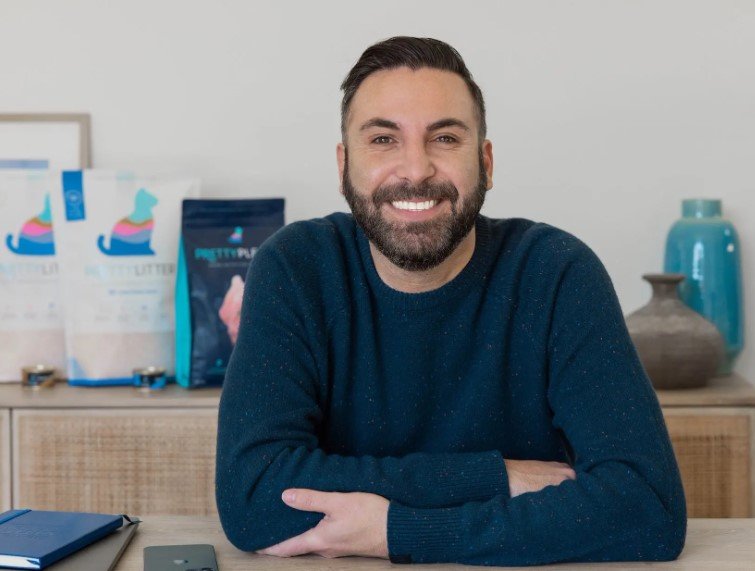Daniel Rotman founded PrettyLitter in 2015 after losing his cat to a hidden illness, turning a personal tragedy into a health monitoring cat litter that earned $760,000 in its first year. Now acquired by Mars for up to $1 billion, the brand helps pet owners detect feline health issues early through innovative color changing technology.
From Personal Pain to Business Idea
Rotman faced a tough loss when his 15 year old cat Gingi suddenly became lethargic and died from an undiagnosed illness. Vets explained that cats often hide symptoms to avoid seeming weak, making early detection hard for owners.
This experience stuck with him. While in a 2015 incubator program, he brainstormed ways to help cat owners spot problems sooner. The idea hit: use the litter box as a daily health check tool by creating litter that changes color based on urine pH levels or blood presence.
He researched veterinary labs to develop a safe formula. The result was PrettyLitter, a lightweight silica gel based product that alerts users to potential issues like urinary tract infections without diagnosing them.

Rotman pitched the concept in the program’s competition and won the consumer facing category. That victory came with a $50,000 prize, giving him the boost to launch.
Rapid Growth and Key Milestones
PrettyLitter started small with a $1 million seed round. In its first year, sales hit $760,000 by tapping into the growing pet care market, where owners seek smart solutions for animal health.
The company expanded quickly. By 2021, Mars acquired it for a reported $500 million to $1 billion, showing strong investor faith in pet tech innovations.
Rotman credits success to understanding cat owners’ needs. The litter not only monitors health but also reduces odor and is lightweight, making it easier to handle than traditional clay options.
Recent data from 2025 shows the pet industry booming, with U.S. spending reaching $147 billion, up from $136 billion in 2023. PrettyLitter fits this trend by blending convenience with wellness.
The brand has sold over 50 million bags, helping countless cats get timely vet care. Partnerships, like a 2020 donation of $100,000 in products to the Humane Society, built community trust.
How PrettyLitter Works and Its Impact
The product’s core is its color changing feature. Normal urine keeps the litter white, but abnormalities trigger shifts to blue for high alkalinity, yellow for acidity, or red for blood, signaling possible infections or other issues.
Users praise it for early warnings. One owner caught a kidney problem in time, saving their cat’s life. Vets recommend it as a simple home monitoring aid.
PrettyLitter also offers health focused cat food, expanding its wellness line. In 2025, with rising pet adoption rates post pandemic, such tools are more vital than ever.
| Feature | Benefit | User Feedback |
|---|---|---|
| Color Change | Detects pH imbalances or blood | “Saved my cat from a UTI” |
| Lightweight Silica | Easy to carry, less dust | “No more heavy bags” |
| Odor Control | Traps smells effectively | “House smells fresh” |
| Subscription Model | Convenient monthly delivery | “Never run out” |
This table highlights why PrettyLitter stands out in a crowded market.
Challenges and Lessons Learned
Starting out, Rotman faced supply chain hurdles in sourcing pH neutral silica gel. He solved this by partnering with reliable labs, ensuring product accuracy.
Marketing was key. Early endorsements, like from Martha Stewart in 2021, boosted visibility. Today, social media buzz on platforms like X shows cat owners sharing success stories.
One challenge is competition from automatic litter boxes, but recent 2024 warnings about unsafe models have pushed demand toward safer options like PrettyLitter.
Rotman advises entrepreneurs to solve real problems. His pivot from public policy to business shows passion drives success.
He learned to scale smartly, growing from a living room startup to a 50 person team. Balancing innovation with affordability kept customers loyal.
Future of Pet Care Innovation
Looking ahead, PrettyLitter plans more products, like advanced monitoring apps tied to litter data. With AI in pet tech rising, Rotman sees opportunities to integrate smart home features.
The 2025 pet care market emphasizes sustainability, so the brand explores eco friendly materials. Rotman’s story inspires new founders in this $3 billion industry niche.
As pet ownership grows, with 70% of U.S. households having pets per 2025 surveys, tools like this could prevent many health crises.
- Health Alerts: Early detection reduces vet bills and stress.
- Convenience: Dust free and lightweight for busy owners.
- Community Impact: Donations support animal welfare groups.
- Market Fit: Taps into trends like remote pet monitoring.
What do you think about pet health innovations? Share your thoughts in the comments and spread this story to fellow cat lovers.








